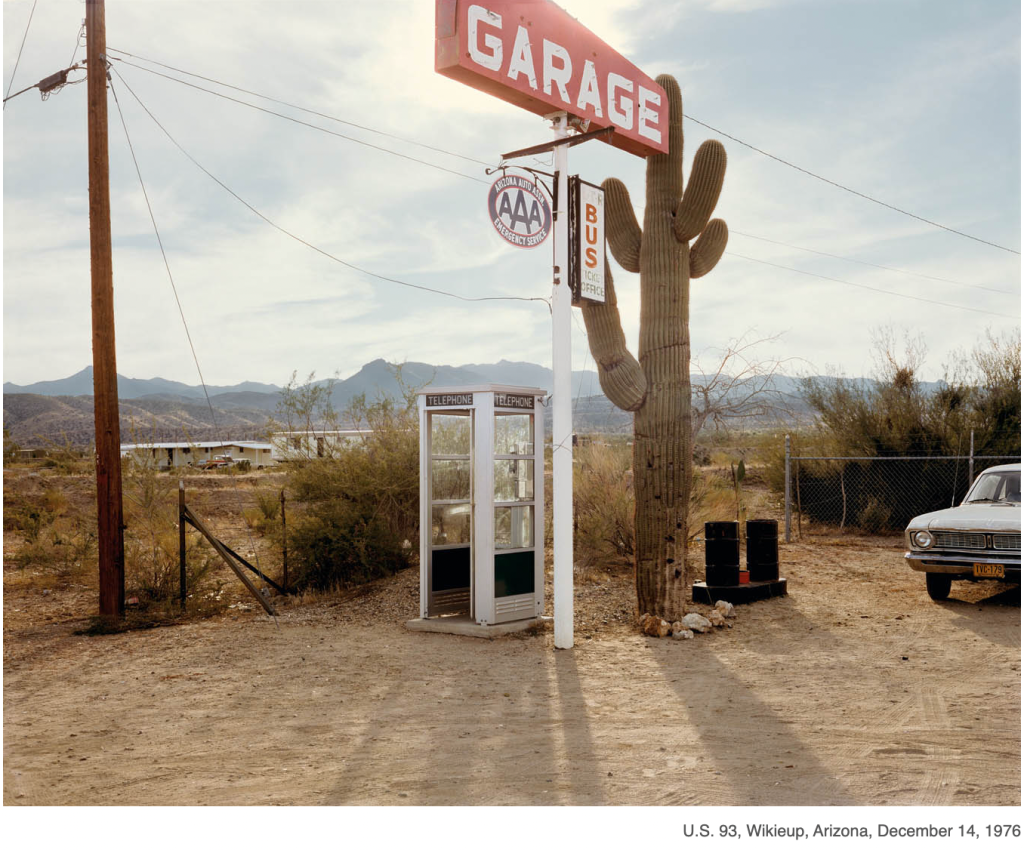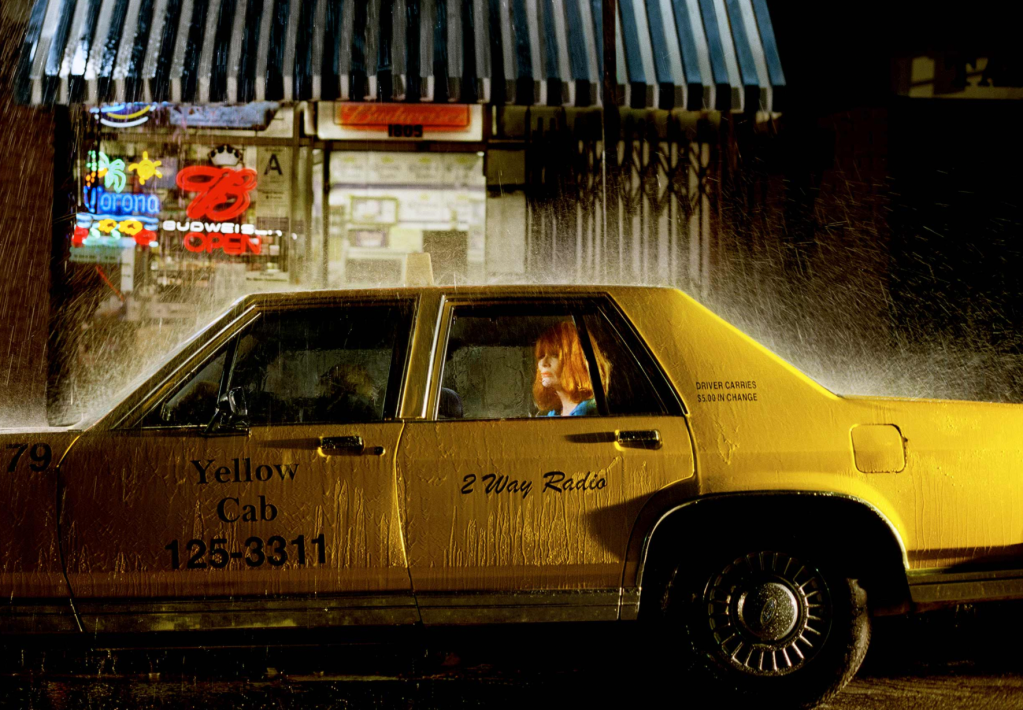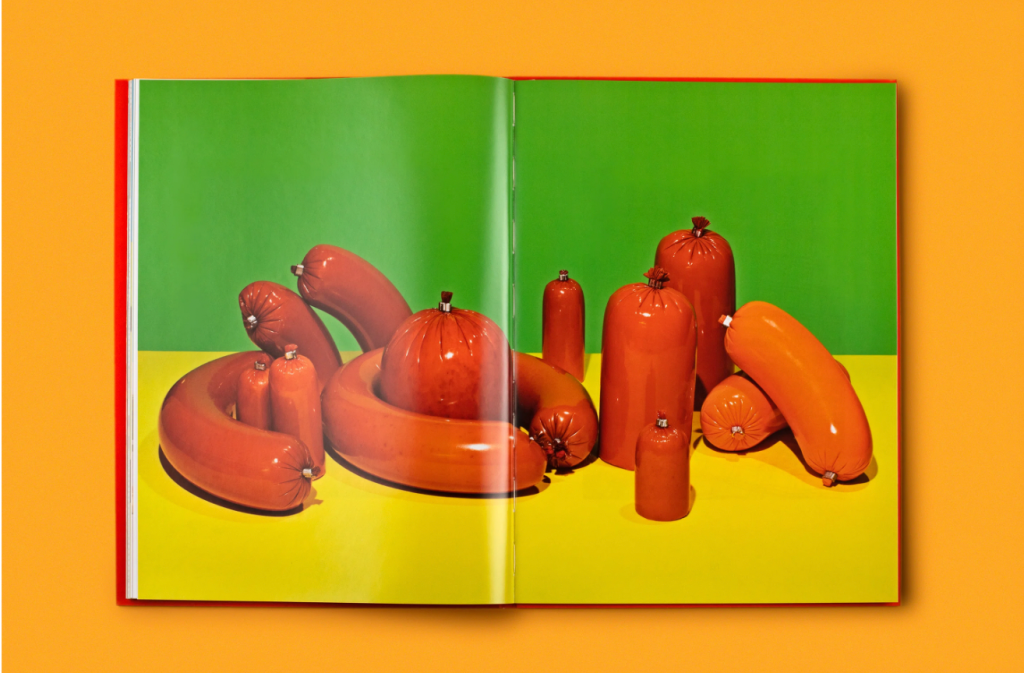Photography is consumed in a manner that is often perceived to represent a true reflection of the captured content. Although the physical elements within an image contain information that is derived from our perception of reality, the photographer is essentially sharing their view or perceived truth. Whether this in the form of the subject matter itself, or the way in which a photograph is taken, the photographer is the story teller and can choose to reveal or hide as much as they wish to within the frame.
In Stephen Shore’s work Uncommon Places, the scenes are perceived as ordinary and candid. However, there is a glassy aesthetic that is achieved through the use of structure, within the artists work. There is a relationship between every line, angle and space between objects, resulting in a uniform and calm appearance, that demonstrates a systematic reality. As a result the scene becomes a stage and the objects become props that are positioned to reflect an ideal scenario.
This presents the question about whether any experience of the same place, is the same as another, as one ‘true’ reflection will never be the same as the other.
As Susan Sontag expresses:
“Photography has the unappealing reputation of being the most realistic, therefor facile of the mimetic arts.”



http://stephenshore.net/photographs/uncommon/index.php?page=1&menu=photographs
Truly Beautiful
In its early delivery, photography was developed as a means to portray the realism of subjects and places in a naturalistic manner, much in the way that paintings would attempt to mirror the world. The idea that images are ‘taken’ or ‘captured’ is a traditional notion that most people connect with, as there is an ontological desire for people to distinguish variations of photographic practice. The concept that images can be ‘made’ is a contrasting belief, as it suggests that subject matter is manipulated, staged and subjectively false. However it is possible for images to be taken and made, depending on the objective of the image. After all, an image of any kind is only a representation of a perceived reality.
Hiroshi Sugimoto’s dioramas are an example of how staged imagery, compromised of real objects and captured scenery, can be created to replicate the naturalistic quality of seeing. Although the images are staged, they represent a reality that we can relate to through the use of recognisable icons and indexical elements, which allow the content to appear as real as it would in the physical location that the image represents. As a result the ambition to capture a scene to inform the viewer in a manner that appears to follow a visual model, succeeds in its intention.

This poses the question as to whether it matters that the image is staged, as the denotation of the image on location or set is ultimately the same. As Uta Barth states in Mirlesse, 2012:
“Mostly the camera is used as a sort of pointing device. One goes out into the world and points it at something of beauty, something of importance, a spectacle of some sort.”
Similarly, the work of Chino Otsuka challenges duplicity and realism, as she adds herself to scenes taken from her youth. The indexical content contributes to the audience’s perception of the imagery and its ability to appear real, while transcending between both time and place. As a result the viewer accepts the imagery and the context in which it is produced.


Roland Barthes acknowledges the notion that an authentic appearance will always dominate representation in his own writing:
“In the photograph the power of authentication exceeds the power of representation.”
Iconic Moments
An image might appear to capture a specific moment in time or a decisive moment, but many images are created using mechanical approaches that exploit constructed elements, in order to appear real or inadvertently manipulated. This is often the case when a specific message is being delivered or if an intended reading of an image is required from the audience. Iconic, indexical and symbolic representation are often interjected into a piece of a work, to ensure that the meaning is understood. Whether this is in the form of intertextuality and the use of historical references or through the use of conventional symbolism, these elements work together to create a narrative that is understood and accepted by the viewer.
Alex Prager is an American photographer that creates iconic scenes inspired by vintage Americana and cinema, to replicate the photographic subject matter and themes often associated with the 1960’s, 1970’s and 1980’s. Her ability to produce images that demonstrate a realistic representation of eras gone by, combined with contemporary image making techniques, bridges both photography and cinema, by using a stylised aesthetic that is often associated with film. The realism imitated within these images, is dependent on the audiences prior knowledge of American culture and often appears satirical and dramatic. Although the scenes are fictional, there are cultural signifiers that factually depict a way of a life gone by. These constructed realities, arguably demonstrate how the direction and staging of scenes contribute towards posterity and cultural understanding, in an equally effective manner as documentary photography would.



As the camera acts as an extension of the photographer, it captures subject matter within a frame that is chosen and constructed by the image maker. Michael Kholer addresses this notion in his writing for Constructed Realities; the art of the staged photography, by reflecting on art practices:
“All art oriented towards realism practices deception. It attempts to create an illusion, namely the illusion that in viewing a painting one is not actually looking at a painted surface, but as through a window—at a segment of reality.”
Subject Matters
In many instances photography has the ability to visually represent multiple layers of reality. It can denote what the viewer can see, have connotations that represent something else and rely on the information that the audience already knows about the context and subject matter. This representation of collective memory, is often regurgitated to represent a mood, feeling and time that replicates familiar ideas about popular culture, within a postmodernist world. To add to the perception of a mirrored world that reflects social appeal and often nostalgia, the introduction of the recycled celebrity, as subject matter, adds another level of interest that causes viewer’s to stop in their tracks.
Nadia Lee Cohen is a British photographer that capture the aesthetics of vintage imagery, through the use of colour, composition and exaggerated subject material. By amalgamating the best of each, her work appeals to the senses and tastes of the current time, with a twist. As people often look back at the suggested ‘Golden ages’ of time, her work presents this aesthetic, while delivering something new that causes audiences to do a double take. To add to the visual display that her work presents, she has had the opportunity to work with famous faces that naturally draw attention to her work. Her recent shoots featuring Kim Kardashian, demonstrate how meticulous styling, combined with old Hollywood glamour create the perfect mix for powerful imagery that champions the female form in a way that confidently addresses the viewer. The attention to detail and the ability to capture scenarios as though they from another time, allows traditional techniques and appearances to remain visible and relevant in progressing times. The carefully endorsed celebrities, in turn contribute to the revival of artistic movements, by gaining recognition in a modern world and allowing them to thrive.


Objectification
Often, when people are asked to visualise a location they will imagine landscapes, streets and rooms that they have seen themselves or experienced through depictions presented through various types of media. The objects that fill these vistas, are often considered as secondary aspects, as they become ‘part of the furniture’ within a place. The ordinary is often overlooked, despite the fact that the ordinary elements of the everyday contribute to the making of history and become the visual references of the future.
Phyllis Ma is a photographer that creates surreal compositions from objects that she discovers on her travels. By juxtaposing texture, colour and form, her creations are striking and anything but ordinary. Her work demonstrates how context can impact the allure of an object to enhance a message and add visual appeal. The objects in turn, become artefacts that interact with one another to present a function, beyond their original intentions.


In 2010, Issa Samb expresses in conversation for ‘How to make objects talk’ how significant objects are and how they have the ability to add meaning to the world that we live in:
“Why do we hold on to sandals that we’ve had since we were fourteen? Why do we keep these sandals if they don’t speak to us any longer? No, they do speak. Objects speak, but speak their own language.”
Experience Something New
Fictional narratives have offered escapism for centuries, inviting participants to lose themselves within imaginary places that present alternative realities. Whether this is designed as an outlet, distraction or antidote to social repression, photography has the ability to make these worlds visually apparent.
Abdulaziz Al-Hosni is a photographer based in Oman. He challenges gender perception through the use of intertextuality that presents vintage imagery with modern objects and themes. By doing this, he creates an expression that challenges traditional views regarding masculinity and social expectations. His work acts as a platform for expressing love and emotion that would otherwise be repressed and celebrates this through the use of composition and colour. The work mirrors known scenes and items such as love potions to create new connotations that are relevant to modern audiences. As a result old and new elements combine to create a new meaning that is devised to have a positive impact amongst viewers.


